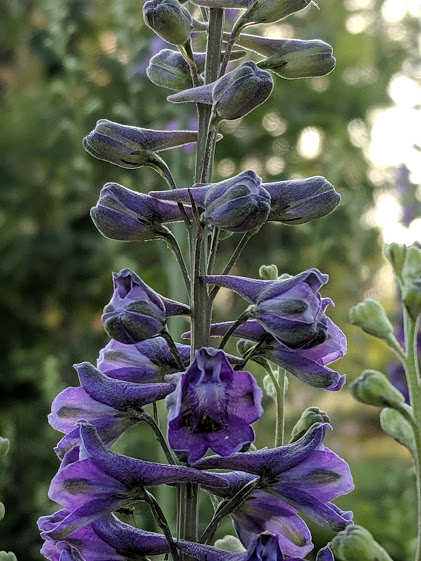Description
Graceful, lavender or purple spikes of trumpets on tall stems in July to August.
Graceful, lavender or purple spikes of trumpets on tall stems in July to August.
Graceful, lavender or purple spikes of trumpets on tall stems in July to August.
Violet racemes all summer through fall
Size: 36” x 12”
Care: Sun, well-drained soil
Native: Southern Europe
Both the Latin and common names are related to flax. Linaria comes from “linum” which is Greek for “flax” and toadflax includes the word “flax.” The leaves of Linaria purpurea resemble flax leaves. According to 17th century English herbalist, John Parkinson, the plant “causes one to make water.” Grown by English plantsman and explorer, Tradescant the Elder, 1634.
June – September (WOW!) short blue-purple, more blue than purple, spikes of compact flowers bloom on short, slowly creeping mat of sword-shaped foliage that suppresses weeds.
Size: 6-8” x 12”
Care: sun to part shade in well-drained soil
Native: Siberia, Mongolia & Kazakhstan
Wildlife Value: attracts pollinators. Drought tolerant; deer and rabbit resistant
According to Christian tradition, as Jesus carried the cross to Calvary, a woman wiped his face with her handkerchief, leaving the imprint of the features of his face, the vera iconica, meaning “true likeness.” When the Catholic Church canonized the woman, the Church gave her the name Saint Veronica. Medieval gardeners named a different Veronica after her due to the perceived likeness of the flower to her handkerchief. Collected by 1950 Russian botanist Nikolái Pávlov (1893-1971) described and named this in Vestn. Akad. Nauk Kazakhsk. S.S.R v.4 p. 92 (Academy of Sciences of the Kazakh SSR) in 1951. Kazakh is the name of the language of people of Central Asia inhabiting mainly Kazakhstan which became independent of Russia in 1991.
SHRUB Boxwood
Size: 24” x 30”
Care: Light to Part shade in well drained, alkaline soil. Do not crowd with other plants, roots prefer no competition. Fertilize regularly for dramatic growth. Prune in early spring. Unlike English boxwood this can be pruned back hard. One of a few shade tolerant evergreens and deer resistant too. Also the most hardy Boxwood.
Introduced from Asia to American and European gardens around 1900 by Ernest Henry “Chinese” Wilson (1876-1930) who scoured Asia for plants.
OUT OF STOCK
Bushy plants bear showy, red-purple pea-like blooms age to rich purple in March-June. Spring gem.
Size: 10” x 10”
Care: sun in north to shade in south, moist well-drained soil. Drought tolerant once established
Native: No. Europe - Siberia
Awards: Royal Horticultural Society Award of Garden Merit, Elisabeth Carey Miller Botanical Garden Great Plant Picks
Introduced to gardens before 1629 when herbalist John Parkinson (1567-1650) called it “Blew Everlasting Pease.”

